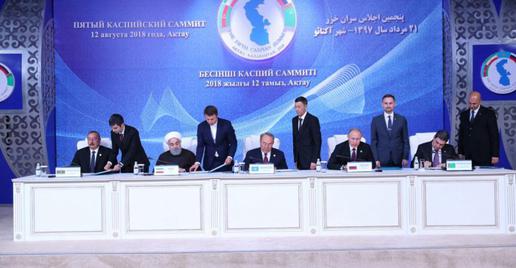One year after the Convention on the Legal Status of the Caspian Sea was signed, the Iranian public has expressed alarm about the fate of a vast expanse of Iran's territory.
On August 12, 2018, the heads of states of Iran, Russia, the Republic of Azerbaijan, Turkmenistan and Kazakhstan, all of which border the Caspian Sea, signed the convention, the culmination of 26 years of negotiations. The agreement, which was signed in the coastal city of Aktau in Kazakhstan, outlines the rules about how the body of water will be governed, but it does not set out each individual country’s Caspian Sea territory.
Anxiety over Iran's share of Caspian Sea waters has grown to such an extent that, on the anniversary of the convention being passed, Foreign Minister Mohammad Javad Zarif was forced to reassure the parliament. “No document will be considered final without the vote of the representatives,” he told the Iranian parliament [Persian link] during a public session. “Until now all decisions about the Convention on the Legal Status of the Caspian have been made with the permission of the Supreme Leader and the signature of His Excellency the Supreme Leader and when the process is complete it will come to the parliament for the final decision.”
Iran and the Soviet Union once shared the Caspian Sea territory. After the dissolution of the Soviet Union in December 1991, however, Russia and Iran were faced with three new countries entitled to territorial rights. Laws passed down from Soviet times were no longer adequate; in addition, the discovery of new oil and gas reserves and the navigation of vessels belonging to states other than the five littoral countries created fresh areas of tensions between them. At last, after close to three decades of negotiations, the heads of states of the countries reached a deal — but the parliaments of the five countries have yet to ratify the convention. Under the constitution of the Islamic Republic, parliament must ratify any international treaty, and it must be approved by the Guardian Council.
How Will the Caspian Sea be Divided?
The Convention on the Legal Status of the Caspian Sea is the “mother document” for all future decisions regarding the sea, but it does not set out the details of each country’s share. After the convention was signed in 2018, it was announced that the next step would be for the littoral states to begin negotiations on the two remaining issues: setting the baselines and the boundaries of the seabed.
A sea baseline is a hypothetical line that connects the tips of the far-most protrusions of the land into the sea. The waters behind this line are considered inner waters of the country. In the Caspian Sea, the waters before this line are to be designated as territorial waters for a distance of 15 nautical miles, or approximately 28 kilometers. As the designation implies, territorial waters are considered part of the territory of a country, meaning no vessel from another country can enter this territory, and no plane can fly over it without permission from that country.
The Caspian Sea and its five littoral states (Source: Google Maps)
Except for Iran, the coasts of the countries that share the Caspian Sea are concave and deep. This means that the baseline will give these four countries a bigger share of inner waters in the Caspian Sea. Unlike those of other littoral states, the Iranian coast is shorter and relatively shallow.
As a result, when the baseline comes to be drawn, Iran will get a smaller share of the Caspian Sea than the other countries do. The convention signed in 2018 notes that when it comes to setting the baselines, the special situation pertaining to Iran must be taken into account. Negotiations have been going on for months now, but no official outcome has been reached.
The Iranian public has not been made aware of what has gone on in negotiations but, in the end, even if the Islamic Republic does not publicize the details, the other countries are bound to make them public. News about the agreement on the convention was first announced by Russia and it was only a few days later that Iranian officials told the media that President Rouhani had traveled to Kazakhstan to sign it.
The Buck Stops with Ayatollah Khamenei
The Iranian parliament is the only branch of the government that has sporadically given voice to concerns about the Caspian Sea — concerns that Foreign Minister Zarif has been quick to address. He has tried reassure parliamentarians that all decisions regarding the convention have been made with the knowledge and the approval of the Supreme National Security Council and the Supreme Leader. For his own part, despite widespread worries about the Caspian Sea, Ayatollah Khamenei has not said a word about the issue.
Iranians generally mistrust Russian intentions and have not forgotten their shared history and the 19th-century wars between them that cost Iran a portion of its territory in the Caucasus. However, Ayatollah Khamenei has ignored this widespread mistrust and expressed a very positive view of Russia and its current head of state, President Vladimir Putin. “The image of the Russian nation in our minds is a good and bright one,” he said during their very first meeting in Tehran in 2007 [Persian link]. “This is because of the fortitude and the wisdom that the Russian nation has shown at various junctures.”
Putin is the only world power leader and representative of a permanent member of the UN Security Council who has met Ayatollah Khamenei three times at the Supreme Leader’s office in Tehran. In July, Putin sent a bill to the Russian Duma for the final approval of the convention on the Caspian Sea.
The Islamic Republic is currently under economic siege by sanctions and tense international relations continue to escalate. The Iranian public is worried that this fragile situation will drive the regime to grant secret concessions to its neighbors when dividing up the Caspian Sea — and especially to Russia — in order to prevent the situation from getting even worse.
Related Coverage:
The Caspian Convention, the Master’s Compromise, August 13, 2018
Will Putin Decide the Fate of the Caspian Sea?, July 16, 2018
The Tale Behind Putin’s Trip To Tehran, November 23, 2015
A Little More East Than West: Iran and Russia, July 28, 2014
visit the accountability section
In this section of Iran Wire, you can contact the officials and launch your campaign for various problems


























comments